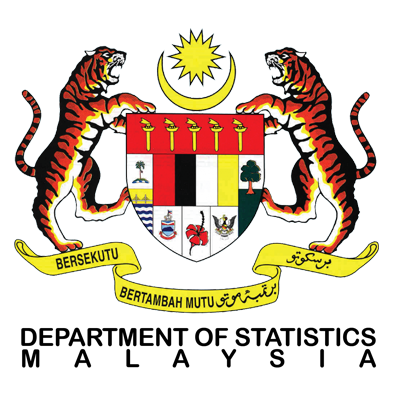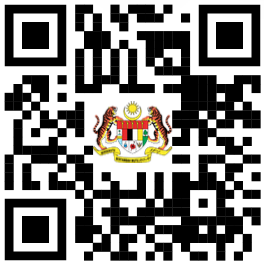Malaysia External Trade Statistics
- Home
- Statistics
- Economy
- External Sector
- Malaysia External Trade Statistics
Malaysia External Trade December Statistics 2019
Malaysia External Trade Statistics November 2019 4 December 2019
Malaysia External Trade Statistics October 2019 4 November 2019
Malaysia External Trade Statistics September 2019 4 October 2019
Malaysia External Trade Statistics August 2019 4 September 2019
Malaysia External Trade Statistics July 2019 2 August 2019
Malaysia External Trade Statistics Jun 2019 Show all release archives
Overview
 ?
?
KEY FACTS
YEARLY
- In 2019, Malaysia’s exports amounted to RM986.4 billion with a decline of 1.7% as compared to last year, while imports worth RM849.0 billion (-3.5%) resulting in a total trade of RM1.8 trillion (-2.5%).
- The decrease in exports were attributed to lower exports to Hong Kong (-RM8.3 billion), Japan (-RM5.1 billion), Australia (-5.1 billion), Singapore (-RM3.4 billion) and the European Union (-RM2.9 billion).
- Imports were down mainly from Singapore (-RM13.5 billion),Taiwan (-RM6.5 billion), the European Union (-RM5.9 billion), Thailand (-RM4.5 billion) and Switzerland (-RM4.1billion).
QUARTERLY
- In 4th quarter 2019, exports recorded a decrease of 3.3% y-o-y to RM257.9 billion. Re-exports was valued at RM45.9 billion decreasing 10.0% and accounted for 17.8% of total exports. Domestic exports fell 1.8% to RM212.0 billion compared to the previous year.
- Imports also registered a decrease of 4.0% y-o-y to RM221.4 billion.
- On a quarter-on-quarter (q-o-q) basis, exports rose 4.4% from RM247.0 billion.
- On a q-o-q basis, imports was also increased 3.7% from RM213.5 billion.
- On a y-o-y basis, the decrease in exports was attributed to lower exports to Japan (-RM3.2 billion), Australia (-RM2.6 billion), Hong Kong (-RM2.4 billion), Thailand (-RM2.1 billion) and Singapore (-RM1.3 billion).
- On a y-o-y basis, lower imports were mainly from Taiwan (-RM2.6 billion), Singapore (-RM2.3 billion), the European Union (-RM2.3 billion), Saudi Arabia(-RM2.0 billion) and Thailand (-RM1.5 billion).
MONTHLY
- Exports in December 2019, increased 2.7% to RM86.4 billion y-o-y. Re-exports was valued at RM14.3 billion registering a decline of 0.3% y-o-y and accounted for 16.6% of total exports. Meanwhile domestic exports recorded an increase of 3.3% or RM2.3 billion to RM72.1 billion.
- Imports marginally increased 0.9% y-o-y to RM73.8 billion.
- On a month-on-month (m-o-m) basis, exports grew 6.8% from RM84.1 billion. In seasonally adjusted terms, exports also increased 8.5%.
- On a m-o-m basis, imports decreased 0.6% or RM439.3 million from RM74.3 billion. In seasonally adjusted terms, imports decreased 1.6%.
- On a y-o-y basis, exports grew due to the increase in exports to China (+RM2.1 billion), the United States (+RM1.2 billion), Indonesia (+RM979.4 million), Taiwan (+RM721.6 million) and Viet Nam (+RM353.3 million). However, exports decreased to Hong Kong (-RM1.2 billion) and Japan (-RM855.5 million).
- On a y-o-y basis, higher imports were mainly from United Arab Emirates (+RM1.9 billion), Japan (+RM857.0 million) and China (+RM473.7 million). Meanwhile, lower imports were from Thailand (-RM719.0 million),Singapore (-RM392.7 million) and Taiwan (-RM392.1 million).
TRADE
Total trade amounted at RM160.2 billion, an increment of 1.9% or RM2.9 billion. It also posted an increment of RM5.1 billion (+3.3%) when compared to November 2019. The trade surplus which was valued at RM12.6 billion, rose RM1.6 billion (+14.7%) from a year ago. It also registered an increase of RM6.0 billion or 90.3% as compared to the previous month.
EXPORTS
On a y-o-y basis, exports increased 2.7% to RM86.4 billion. The main products which attributed to the increase were:
- Refined petroleum products, which accounted for 7.1% of total exports, increased RM1.6 billion or 35.2% to RM6.2 billion due to the increase in export volume (+35.3%) as average unit value decreased 0.04%;
- Palm oil and palm oil-based products (6.7% of total exports), grew RM1.0 billion (+20.9%) to RM5.8 billion. Exports of palm oil, the major commodity in this group of products rose RM910.7 million or 34.5% due to the increase in both export volume (+13.1%) and average unit value (+18.9%);
- Timber and timber-based products (2.3% of total exports) increased RM180.9 million or 9.8% to RM2.0 billion; and
- Natural rubber (0.3% of total exports) increased RM21.9 million or 8.1% to RM293.7 million due to the increase in both export volume (+4.8%) and average unit value (+3.1%).
However, the following products recorded decreases:
- Electrical and electronic (E&E) products, which accounted for 35.9% of total exports, dropped RM1.8 billion or 5.4% to RM31.0 billion;
- Liquefied natural gas (LNG), which accounted for 4.1% of total exports shrank RM961.6 million or 21.3% to RM3.6 billion due to the decrease in average unit value (-24.6%) as export volume increased 4.5%; and
- Crude petroleum, which accounted for 2.9% of total exports, fell RM799.3 million or 24.3% to RM2.5 billion due to the decrease in both average unit value (-1.4%) and export volume (-23.2%).
On a m-o-m basis, exports increased RM5.5 billion (+6.8%) from RM80.9 billion. The main products which contributed to the increase were:
- E&E products rose RM3.5 billion (+12.5%) from RM27.6 billion;
- Refined petroleum products increased RM865.7 million or 16.3% from RM5.3 billion due to the increase in both export volume (+13.9%) and average unit value (+2.1%);
- Palm oil and palm oil-based products grew RM416.6 million or 7.7% from RM5.4 billion. Exports of palm oil rose RM358.9 million or 11.2% due to the increase in average unit value (+13.8%) as export volume dropped 2.2%;
- LNG, increased RM343.0 million (+10.7%) from RM3.2 billion due to the increase in both export volume (+10.3%) and average unit value (+0.3%);
- Crude petroleum grew RM299.7 million or 13.7% from RM2.2 billion due to the growth in both export volume (+8.1%) and average unit value (+5.2%);
- Natural rubber rose RM21.2 million or 7.8% from RM272.5 million due to the increase in both export volume (+6.4%) and average unit value (+1.3%); and
- Timber and timber-based products rose RM15.9 million (+0.8%) from RM2.0 billion.
Exports to Country of Destination
The two major destinations for Malaysia’s exports in December 2019 were China and Singapore.
Exports to China amounted to RM13.7 billion, which accounted for 15.8% of total exports, increased RM2.1 billion (+17.8%) as compared to the previous year. The main products which attributed to the rise were:
- Measuring, checking, analysing and controlling instruments and apparatus, which contributed 5.4% of total exports surged RM447.9 million to RM742.9 million; and
- Palm oil and palm oil-based products (8.0% of total exports), increased RM299.5 million to RM1.1 billion.
Exports to Singapore were valued at RM11.6 billion, which accounted for 13.4% of total exports, declined RM322.2 million (-2.7%). The main product which attributed to the decrease was E&E products, which contributed 40.6% of total exports fell RM1.0 billion (-17.9%) to RM4.7 billion.
Seasonally Adjusted Export Value
On a m-o-m basis seasonally adjusted terms, exports increased RM6.5 billion (+8.5%) to RM83.8 billion.
Exports, 2015-2019

IMPORTS
On a y-o-y basis, imports increased RM665.1 million or 0.9% to RM73.8 billion. The increase in import was mainly contributed by intermediate goods and consumption goods.
- Intermediate Goods
These goods which constituted 56.7% of total imports rose RM2.4 billion (+6.0%) to RM41.8 billion. The increase was mainly contributed by fuel & lubricants, primary (+RM686.4 million, +22.8%), industrial supplies, primary (+RM677.0 million, +28.0%) and industrial supplies, processed (+RM600.0 million, +3.7%). However, fuel & lubricants, processed, others decreased RM546.2 million (-32.5%).
- Consumption Goods
Imports of consumption goods which constituted 9.2% of total imports recorded an increase of RM212.1 million (+3.2%) to RM6.8 billion. The growth was mainly contributed by food & beverages, primary, mainly for household consumption (+RM256.3 million, +31.2%) and durables (+RM91.2 million, +10.6%). However, imports of food & beverages, processed, mainly for household consumption decreased
RM180.9 million or 9.0%.
- Capital Goods
Imports of capital goods, which accounted for 11.7% of total imports, dropped RM1.1 billion (-10.9%) to RM8.6 billion due to the decline in both capital goods (except transport equipment) (-RM878.7 million, -9.9%) and transport equipment, industrial (-RM175.8 million, -20.8%).
On a m-o-m basis, imports decreased RM439.3 million or 0.6% from RM74.3 billion. The decrease in imports by end use was mainly attributed to capital goods.
- Capital Goods
Imports of capital goods decreased RM1.2 billion (-11.8%) from RM9.8 billion due to the decrease in both capital goods (except transport equipment) (-RM739.2 million, -8.5%) and transport equipment, industrial
(-RM418.4 million, -38.5%).
- Intermediate Goods
These goods soared RM847.8 million (+2.1%) from RM41.0 billion. The main component contributed to the increase was fuel & lubricants, primary (+RM1.9 billion, +109.4%). Nevertheless, imports of parts and accessories of capital goods (except transport equipment) recorded a decrease of RM1.3 billion (-9.3%).
- Consumption Goods
Imports of consumption goods registered an increase of RM63.5 million (+0.9%) from RM6.8 billion. The increase was due to food & beverages, primary, mainly for household consumption (+RM166.9 million, +18.3%), semi-durables (+RM111.2 million, +8.8%), and durables (+RM31.8 million, +3.5%).
Imports by Country of Origin
The two main sources of Malaysia’s import in December 2019 were China and Singapore.
Imports from China which registered RM16.0 billion rose RM473.7 million (+3.1%) when compared to December 2018. The main products which contributed to the growth were:
- Refined petroleum products (6.3% of total imports), increased RM577.7 million or 133.3% to RM1.0 billion; and
- Furniture and parts, which contributed 1.9% of total imports grew RM157.4 million or 111.6% to RM298.6 million.
Imports from Singapore amounted to RM7.2 billion decreased RM392.7 million (-5.2%) from a year ago. The main product which attributed to the decrease was E&E products (31.8% of total imports), decreased RM238.8 million or 9.4% to RM2.3 billion.
Seasonally Adjusted Import Value
On a m-o-m basis seasonally adjusted terms, imports decreased RM1.1 billion (-1.6%) to RM72.1 billion.
Imports, 2015-2019

MARKET SHARE
The following charts show Malaysia's major trading partners for January - December 2019.
Total Trade by Major Countries, Jan – Dec 2019, percentage share

Exports and Imports by Major Countries, Jan – Dec 2019, percentage share

The following charts show Malaysia’s trade with ASEAN countries for the period of January – December 2019.
Exports, Jan – Dec 2019, percentage share

Imports, Jan – Dec 2019, percentage share

#Notes:
1. The December 2019 data is provisional and subject to revision in later issues.
2. This report can be accessed through the web portal of the Department of Statistics, Malaysia (https://www.dosm.gov.my) under section: Latest Release.
Released By:
DATO' SRI DR. MOHD UZIR MAHIDIN
CHIEF STATISTICIAN MALAYSIA
DEPARTMENT OF STATISTICS, MALAYSIA
![]() DrUzir_Mahidin
DrUzir_Mahidin ![]()
![]() Dr_Uzir
Dr_Uzir
4 FEBRUARY 2020
Contact person:
Mohd Yusrizal Ab Razak
Public Relation Officer
Strategic Communication and International Division
Department of Statistics, Malaysia
Tel : +603-8885 7942
Fax : +603-8888 9248
Email : yusrizal.razak[at]dosm.gov.my
Subscribe
Newsletter
Subscribe to our newsletter and stay updated
For interviews, press statement and clarification to the media, contact:
Baharudin Mohamad
Public Relation Officer
Email: baharudin[at]dosm.gov.my
Phone: 03 8090 4681
Not found what you looking for? Request data from us, through
Go to eStatistik
Email: data[at]dosm.gov.my
Phone: 03 8885 7128 (data request)










